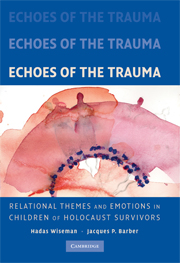Book contents
- Frontmatter
- Contents
- Foreword by Dan Bar-On
- Preface
- Acknowledgments
- 1 Introduction – A Narrative Approach to Bridging the Gap between Clinical Case Studies and Empirical Research on Children of Holocaust Survivors
- 2 Studying Relationship Narratives with the Core Conflictual Relationship Theme Method
- PART ONE RELATIONAL THEMES IN THE NARRATIVES
- PART TWO EMOTIONS IN THE NARRATIVES
- 6 Anger
- 7 Guilt, Shame, and Embarrassment
- 8 Anxiety and Helplessness
- 9 Loneliness
- 10 Joy and Pride
- PART THREE HEALING TRAUMA IN THE CHAIN OF THE GENERATIONS
- Appendix
- References
- Index
8 - Anxiety and Helplessness
Published online by Cambridge University Press: 29 July 2009
- Frontmatter
- Contents
- Foreword by Dan Bar-On
- Preface
- Acknowledgments
- 1 Introduction – A Narrative Approach to Bridging the Gap between Clinical Case Studies and Empirical Research on Children of Holocaust Survivors
- 2 Studying Relationship Narratives with the Core Conflictual Relationship Theme Method
- PART ONE RELATIONAL THEMES IN THE NARRATIVES
- PART TWO EMOTIONS IN THE NARRATIVES
- 6 Anger
- 7 Guilt, Shame, and Embarrassment
- 8 Anxiety and Helplessness
- 9 Loneliness
- 10 Joy and Pride
- PART THREE HEALING TRAUMA IN THE CHAIN OF THE GENERATIONS
- Appendix
- References
- Index
Summary
The themes of anxiety and helplessness in the relational narratives of children of survivors manifest themselves not only through the parents' actual or perceived responses to situations [Responses of Others (RO)] but also through the narrators' own reactions [Responses of Self (RS)]. We have already described the children's perceptions of the parents' vulnerability and suffering that led to the sons' and daughters' need to protect their parents as part of the central relational dynamics of mutual overprotection (Chapter 4). In this chapter, we focus on the narratives that we identify as exemplifying how the parents' anxiety and/or feelings of helplessness are etched in the narrators' emotional memories of their parents and of themselves.
ANXIETY/FEAR
Fear is considered to be a primary emotional experience that is innate and evolutionarily adaptive. Experiencing fear (or any emotion, for that matter) is an extremely complicated process consisting of perception, neurobiological responses, expressive behaviors, and cognitive appraisals. Although most people experience fear relatively infrequently, it is thought to be the emotion that many people dread the most (Izard, 1991). The felt or perceived threat to the individual's security or safety motivates efforts to alleviate the threat and escape from harm. An intense experience of fear is usually vividly remembered for a long time, including the scene associated with the fear experience (Izard, 1991).
- Type
- Chapter
- Information
- Echoes of the TraumaRelational Themes and Emotions in Children of Holocaust Survivors, pp. 133 - 153Publisher: Cambridge University PressPrint publication year: 2008



